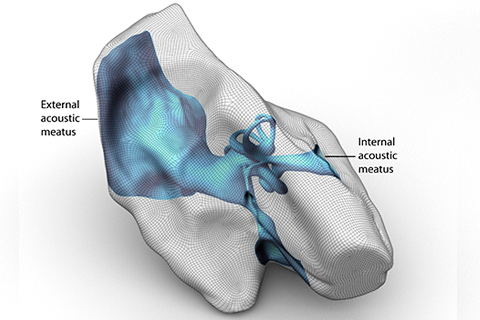Medical illustrations aren’t what they used to be – the delicate line drawings of yore. Andréa Zariwny, a master’s student in biomedical communications, has used gaming software, 3-D modelling and a CT scan to create a technology that could change the way medical students learn anatomy. As a first step, she has designed a tablet-based guide to the ear that highlights its intricate inner structure.
Traditional illustrations don’t begin to suggest the ear’s internal complexity. The semicircular canals, which are responsible for balance, operate in three separate planes. The cochlea, which is crucial to hearing and usually described as snail-shaped, is actually more space than structure – a tiny spiral tunnel, only four millimetres at its widest, that is inseparable from the bone that contains it.
Zariwny’s solution is a 3-D model of the bone containing the inner and middle ear, which she had “printed,” based on a high-resolution CT scan, using a 3-D printer. She paired this with an app that allows users to display the ear’s internal structure. Students point a tablet at the model and press onscreen buttons to see more or less detail. Push one button and you can see all the internal space; push another and you see only the bony labyrinth that contains the cochlea and the semicircular canals. Labels pop up on command and the ear’s inner spaces are rendered as brightly coloured 3-D graphics. Crucially, you can also hold the physical model while viewing an augmented version of its image onscreen, thus providing the ultimate in hands-on learning.
So far the device has been tested for usability on a small number of students, but Zariwny’s content adviser, Prof. Patricia Stewart, says there’s no doubt it will help medical students learn. “Any anatomist looking at it would think it is such a quantum leap from a flat two-dimensional illustration.”
Watch a demo video of the augmented reality app
Recent Posts
U of T’s Feminist Sports Club Is Here to Bend the Rules
The group invites non-athletes to try their hand at games like dodgeball and basketball in a fun – and distinctly supportive – atmosphere
From Mental Health Studies to Michelin Guide
U of T Scarborough alum Ambica Jain’s unexpected path to restaurant success
A Blueprint for Global Prosperity
Researchers across U of T are banding together to help the United Nations meet its 17 sustainable development goals






